Gosport’s World War One Memorial Tank
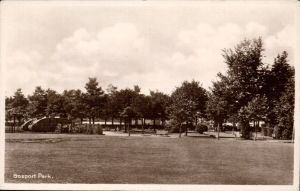
The press reported on the use of the new ‘heavy armoured car’ or ‘tank’ days after its first use on 15 September 1916. Mk IV tanks began production in March 1916 and first appeared on the WWI battlefield at Messines, which began on 28 May 1917. In profile this tank was a rhomboid which was higher at the front than at the back with a raised cab for the driver and commander. Its weapons were carried in two side sponsons each manned by two men. Male tanks had larger sponsons for a 57mm six-pounder 6cwt Mark I gun with a Lewis machine gun as a secondary weapon. Female tanks had two Lewis machine guns in each sponson. Each Lewis MG could be moved to another mount, one being provided at the front cab of both male and female tanks.
The tank was powered by a six-cylinder Daimler engine driven through a primary gearbox and differential to a secondary gearbox in each of the frames at either side. A loop chain then connected to each of the toothed drive sprockets at the back. This engaged with the inner face of the tracks which ran all the way round the track frames imparting excellent cross-country performance. A 70-gallon fuel tank was placed low down at the back. The total number of men required in each tank was eight. MK IV tanks last saw action on 4 November 1918 at the Mormal Forest area. The Mk IV was obsolete before the end of the War. Some continued in service as supply tanks.
Coinciding with the Battle of Cambrai 20 November 1917, in which 378 tanks were deployed with great success, a pair of Mk IV tanks took part in London’s Lord Mayor’s Show, also in November 1917. A tank was incorporated into an exhibition of weapons in Trafalgar Square. As this was a success the National War Savings Committee set up five MK IV male travelling tanks that toured England and Wales selling War Bonds and later Victory Bonds at the cessation of the War.
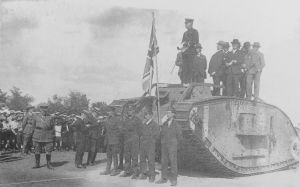

In 1919 the National War Savings Committee, with the agreement and cooperation of the War Office offered MkIV tanks for distribution to towns and cities in England and Wales that had raised a certain threshold of finance per head of population. 265 communities were nominated, plus an unknown number in Scotland. Those that qualified received a MkIV Female tank, mostly ones used for training at Bovington. Female tanks were provided because there were more of them and it was felt that they would be less of a threat to established authority when delivered minus their machine guns. Some males were distributed to location associated with the tank’s development although some places that were added to the initial list also got males. HMS Excellent Royal Naval Gunnery School on Whale Island at Portsmouth received a Mk IV male on 1st of May 1919, which is now on display at Bovington Tank Museum as training tank 102. Portsmouth received its tank in 1920.
In November 1918 Gosport and Alverstoke Urban District Council minuted that they had asked the War Office for some captured german guns. In January 1919 the War Office replied that there was no general distribution of War Trophies but suggested asking the 3rd Battalion of Hants Regiment. In February 1919 the 3rd Battalion said that they had no trophies, ask 1st or 2nd Battalion BEF in France. In June 1919 it was decided to take no more action but then three german (machine?) guns were allocated to the UDC and the War National Savings Committee then offered a tank as a War Trophy which was accepted. The War Office were to deliver the tank on 27 August 1919 and put it in Gosport Park. The Council attached a plate on a 77mm gun displayed in the Park ‘Presented by 56th Brigade RGA’. Alongside it was a german howitzer. In February 1920 surplus money left over from the Peace Celebration was put towards the fencing in and painting of the tank and three German guns. Tank 2809 was ‘Evangeline’, (rumours were that she later had other names) a Mk IV tank, one of the 5th or ‘E’ Battalion tanks manufactured in 1917. An engraved plate was fitted to the tank outlining its history, which was prepared by the National War Savings Committee.
The Hampshire Telegraph reported Friday 29 August 1919:
With a glorious, if somewhat gory, past and a record of deeds nobly done in the country’s defence, Gosport’s tank, the souvenir of the great war which is to commemorate for all time Gosport’s great financial effort towards the winning of the war, came to the town on Wednesday, and with all due ceremony and military pageantry was formally handed over by the Service authorities to the town.
Now after many crowded hours of life “Evangeline” has come to Gosport Park and there on a concrete bed she will remain, to serve as a reminder to generations yet to come of what their forebears did towards financing the war. An official record of “Evangeline’s” history is being prepared by the National War Savings Committee, and when engraved on a plate will in due course be affixed to her side.
The tanks were delivered by rail and then driven to their resting place, usually a public park or square, which in the case of Gosport was a position in Gosport Park. Local dignitaries were primed with anecdotes about this particular tank’s wartime history so that they could use it in their acceptance speech. However as, unlike Gosport’s tank, many of the tanks had seen no wartime service, this was mainly fictitious. Some towns refused a tank on moral grounds or because they had no where to park them. At Gosport on 27 August 1919 a parade around the town from Forton to Alverstoke School took place with the band of the RMLI at the head. At Alverstoke school the tank was waiting, having gone on ahead that morning. The tank joined the procession to Gosport Park under her own power, flying the Union Flag forward and the paying off pennant aft, where Captain Farrall M.C. the tank commander, handed the tank over to Brigadier General Trotman. The tank was given over to the Chairman of the Council. Mr J.H. Spencer, and presented to the people of Gosport as some ‘small memento of the Nation’s gratitude to Gosport for the efforts that they had made in the various War Loans’. Since October 1916, when the War Loans Committee came in to being, Gosport had raised £158,788 in Submarine Week, £316,587 in Guns Week and £224,582 in the Victory Loan Campaign. A total of £1,000,000 had been raised by the people of Gosport. Mr Spencer, in his speech, remarked that the tank would serve as a reminder to the future generations of their efforts. As it was the commander’s prerogative to name the tank he named it ‘Clara Spencer’, after the wife of the Chairman.
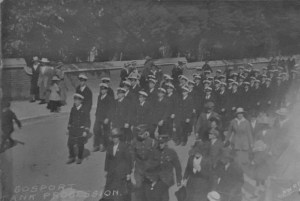
Many communities were not happy with the tanks and by 1937 most had been removed, scrapped or had simply disappeared without anyone mentioning the fact. Others were scrapped during World War Two except for one at Ashford. The Ashford tank probably survived because electrical equipment was installed in it by the South Eastern Electricity Board. It was declared as a War Memorial in 2006. The date of the removal (scrapping) of Gosport’s tank is not known, but in 1933 a newspaper article noted that Gosport Council no longer wanted the tank. The Open Spaces Committee recommended to the Council that it be painted and shrubs be planted all around it. Councillor Ford suggested that it be placed on one of Gosport’s dumps and covered with the town’s refuse ‘so that we can forget it’. Councillor Bartlett suggested that they dig a hole alongside it and push it in. On 20th october 1933 it was reported that Alderman Upton said that ‘he would give his blessing to anyone who would relieve him of this incubus, whether by legitimate or nefarious means’ that it ‘is ugly and does not perpetuate a memory with which we would agree’. It was suggested that it be offered at tender for scrap.
The Portsmouth Evening News – Tuesday 19 December 1933 reported that The Open Spaces Committee last night recommended the Council accept an offer of £14 for the tank. The Council agreed. ‘The embarrassment which the Gosport Borough Council felt as the result of their possession of a war tank, and concerning which several members made uncomplimentary remarks at a recent meeting, has been entirely removed. The suggestions that it should be buried, or used as a support for climbing plants, were not acted upon.’

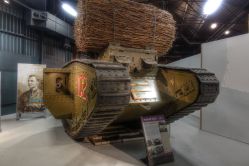
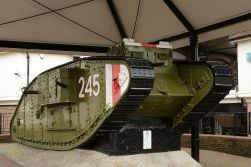
Links:
Whale Island Tank number 2324
Portsmouth memorial Tank
Sources:
Various newspaper articles including:
Gosport Tank Hampshire Telegraph – Friday 29 August 1919
Minutes of GUDC (thanks to Mr. P. Eley)
British Battle Tanks World War 1 to 1939 by David Fletcher.
Great War Tank Mk IV Haynes Owner’s Workshop Manual
Landships website Mk IV serial numbers
Original page created by David Moore.
